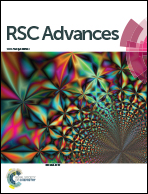One-step deposition of a melanin-like polymer on individual Escherichia coli cells exhibiting a special UV resistance effect
Abstract
Melanin has an excellent ability to absorb UV radiation and to convert harmful radiant energy into heat or antioxidants. Therefore, melanin has a significant potential to endow fragile organisms such as recombinant or bioengineered microbes with a photoprotective ability. Inspired by mussel adhesive foot protein, a dopamine monomer (DA) was reported to self-polymerize into a melanin-like polymer, named polydopamine (PDA). Herein, combining the similarity to natural melanin and chemical adhesivity of the melanin-like PDA polymer, we prepared PDA encapsulated Escherichia coli cells (E. coli@PDA) with a simple method. The PDA encapsulation could retain E. coli cells viability and inhibited cell division. More importantly, the aromatic PDA shells could absorb the UV light and protect the cells against damage from UV radiation. After a prolonged exposure time to UV radiation, the protein stability, cellular metabolically active and cell viability of the E. coli cells were preserved. We believe that our work provides new insights for both fundamental research and applications of cell encapsulation for UV resistance.


 Please wait while we load your content...
Please wait while we load your content...